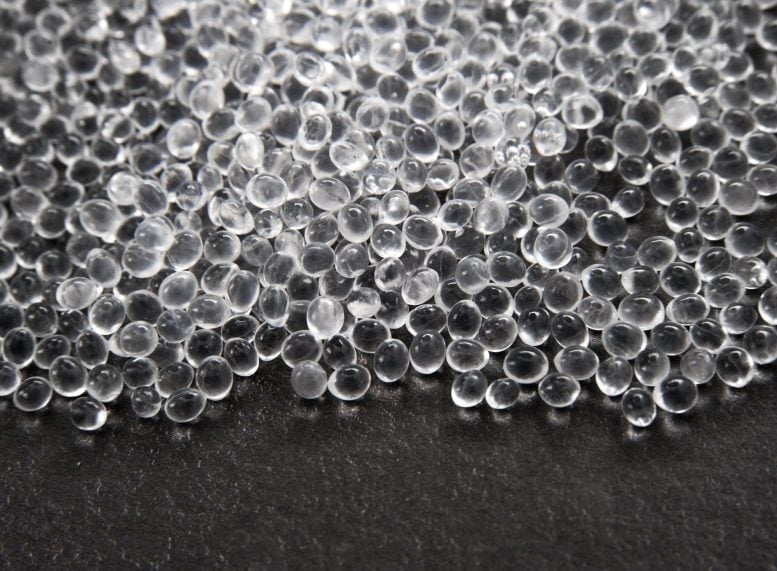
Synthetic polymers, which are ubiquitous in modern life, include materials such as nylon and polyester fabrics, Teflon-coated cookware, and epoxy adhesives. On a molecular scale, these polymers consist of lengthy chains of monomers, the complexity of these chains enhancing the functionality of these diverse materials.
In particular, copolymers, which consist of different types of monomers in the same chain, allow for fine-tuning of the material’s properties, said Peng Chen, the Peter J.W. Debye Professor of Chemistry in the College of Arts and Sciences (A&S). The monomer sequence plays a critical role in a material’s properties, but scientists until now have lacked a method for sequencing synthetic copolymers.
CREATS: A New Sequencing Technique
Chen and colleagues have developed CREATS (Coupled REaction Approach Toward Super-resolution imaging), which allows them to image polymerization catalysis reactions at single-monomer resolution and, through fluorescent signaling, to differentiate monomers from one another. Both are important steps in discovering the molecular composition of a synthetic polymer.
They describe the technique and the first discoveries they’ve made with it in a recent study published in the journal Nature Chemistry.

Co-lead authors are Rong Ye, Xiangcheng Sun, and Xianwen Mao, all former postdoctoral researchers in the Chen group. Co-authors are former Chen group postdoctoral researchers Susil Baral and Chunming Liu, current postdoctoral researcher Felix Alfonso, and Geoffrey Coates, the Tisch University Professor in chemistry and chemical biology (A&S).
“Synthetic polymers are made of monomer units linked together like a string of beads,” Chen said. In the simplest polymers, the monomers are identical, but more complex properties arise when polymers contain monomers of different sorts – called copolymers. The precise arrangement of the monomers in a copolymer plays an important role in its properties, such as stiffness or flexibility.
Significance of Monomer Sequence
Sequence plays a role in the properties of natural polymers, too, Chen said. A protein, for example, is made of 20 amino acid monomers arranged in a very specific sequence.
“In a natural polymer, nature has control,” Chen said. “In synthetic polymers, humans are making the arrangements, and the chemists generally don’t have that precise control.”
Sequencing copolymers is so difficult in large part because of heterogeneity in synthetic polymers, Chen said. Individual chains differ in length, composition, and sequence, which requires single-polymer sequencing methods that can resolve and identify individual monomers.
Some modern methods allow scientists to control the arrangement of monomers in a chain, Chen said, but only for very short polymers – 10 to 20 monomers long.
The Future of Polymer Design
Using CREATS, the researchers can determine the sequence of a polymer as it is made, one monomer at a time, by imaging and identifying every single monomer as it is added to the polymer. To make the monomers visible, CREATS couples the polymerization reaction with another reaction that produces fluorescent signals.
“Every monomer that goes in gives off a puff of light,” Chen said. “The light is induced by a laser, and the puff of light has a color. In our case, it’s either green or yellow. By seeing whether it’s yellow or green, we see what monomer goes in.”
The lab is already equipped to measure synthetic polymer properties. Now that they can determine the sequence of an individual polymer, a next step is to combine the two experiments to correlate structure and function, ultimately providing guiding principles for polymer design to achieve certain properties.
“If you know how sequence controls property, you can really think about designing whatever sequence you want to achieve a certain property,” Chen said. “This knowledge presumably can help people tailor their materials for a desired application.”
Reference: “Optical sequencing of single synthetic polymers” by Rong Ye, Xiangcheng Sun, Xianwen Mao, Felix S. Alfonso, Susil Baral, Chunming Liu, Geoffrey W. Coates and Peng Chen, 9 November 2023, Nature Chemistry.
DOI: 10.1038/s41557-023-01363-2
The research was funded by the Polymer Chemistry program of Army Research Office, a directorate of the U.S. Army Combat Capabilities Development Command Army Research Laboratory.